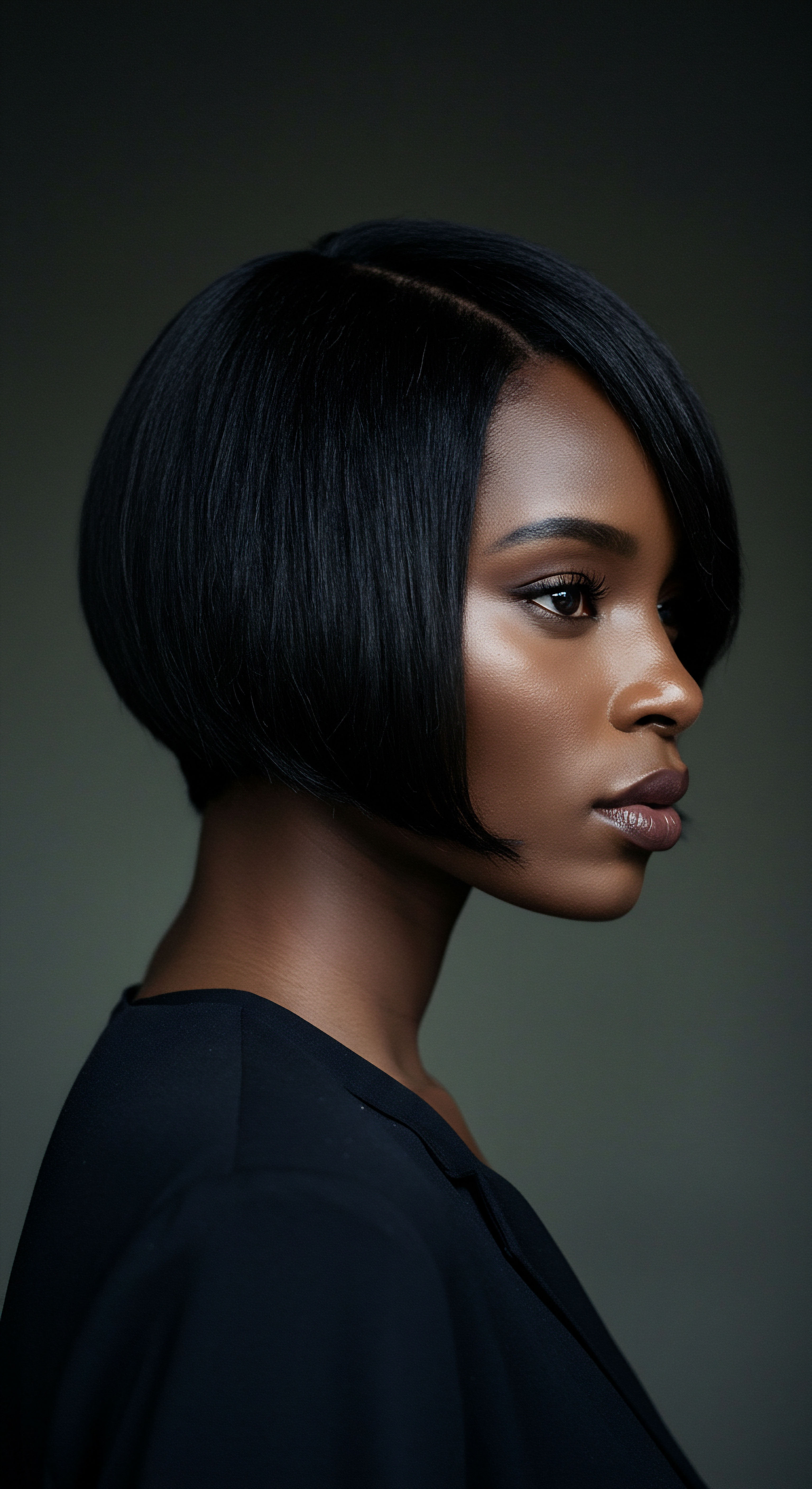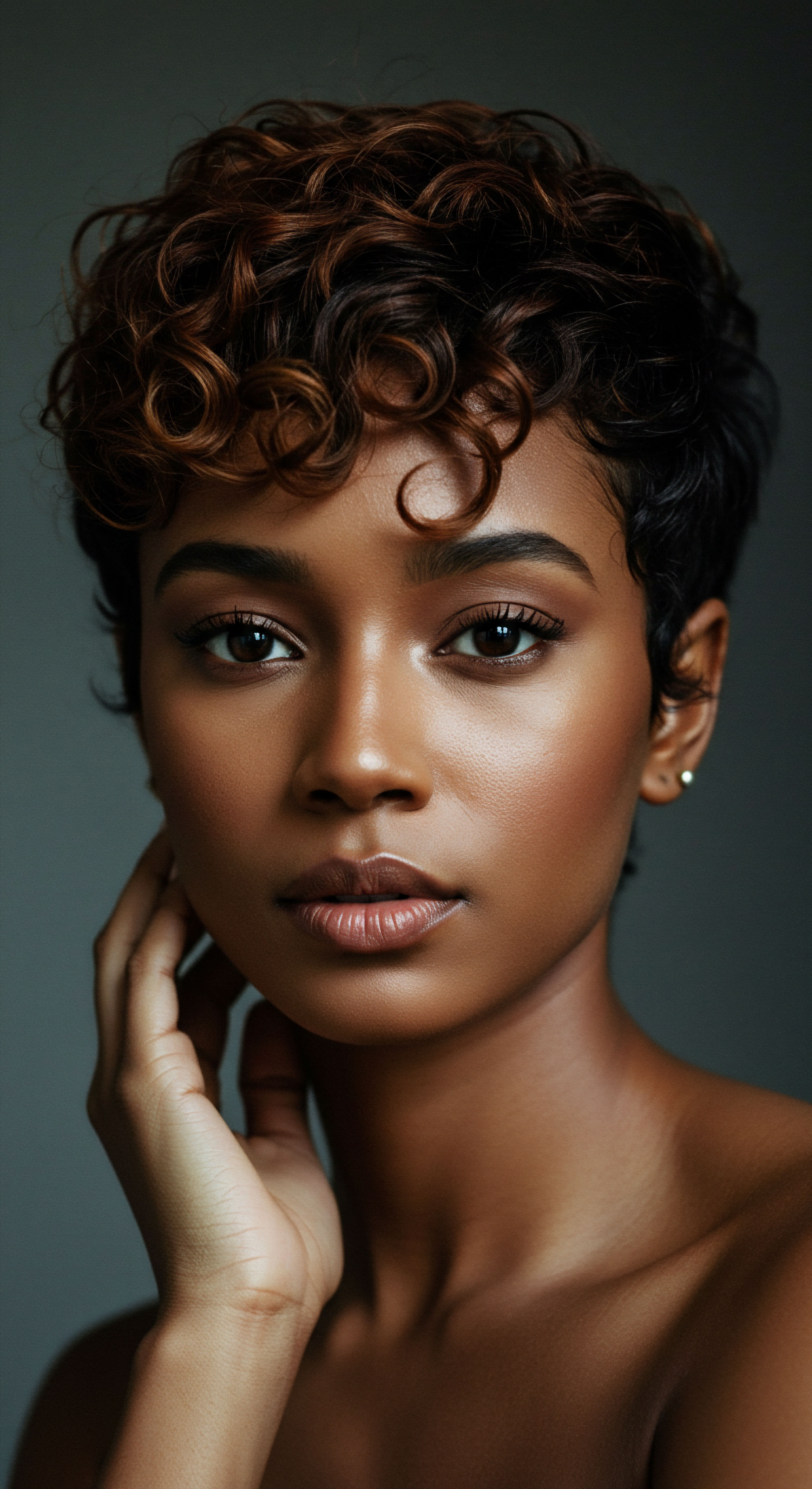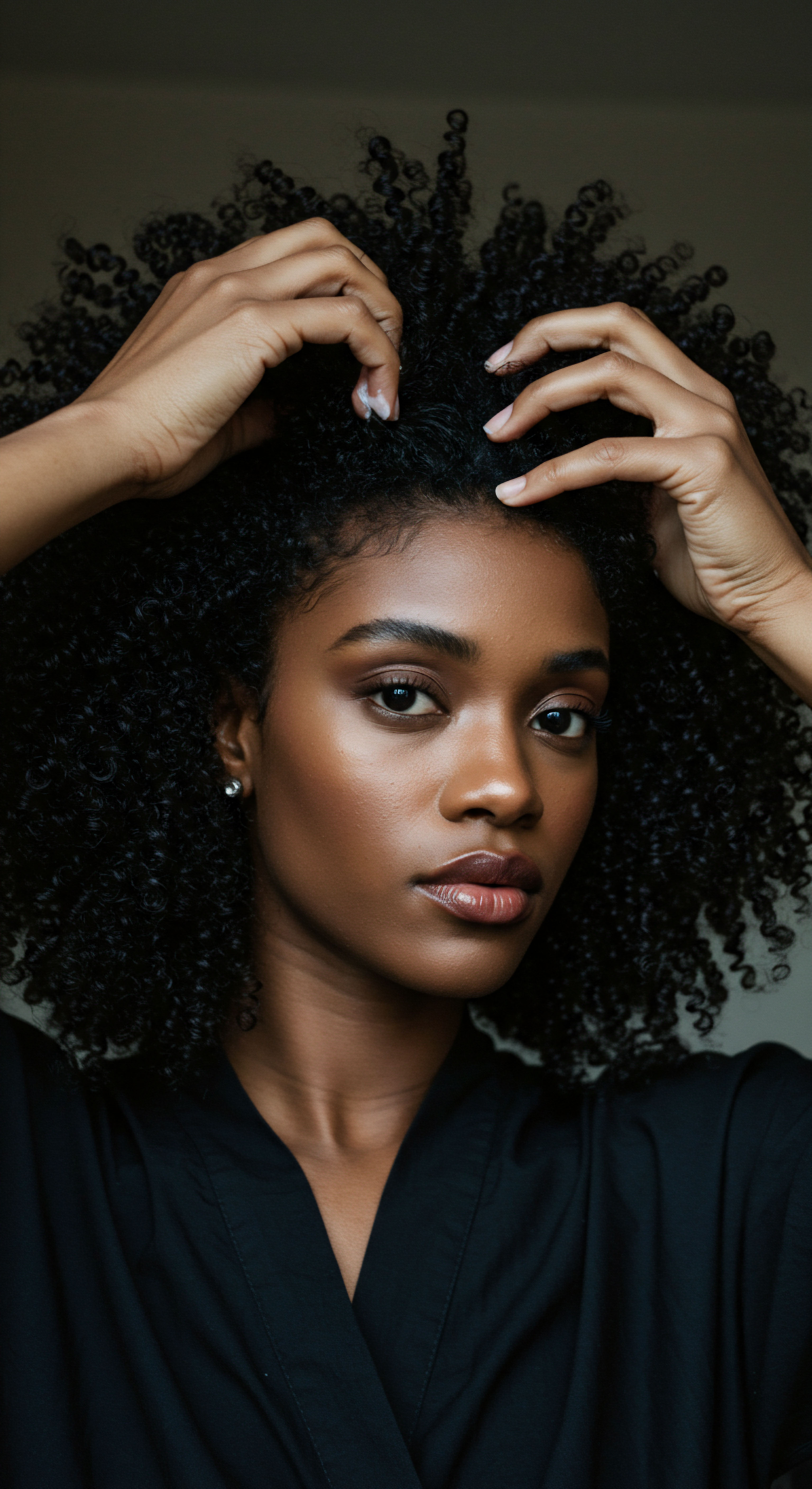
Fundamentals
The journey of a single strand of hair, from its nascent beginnings deep within the skin to its eventual release, unfolds through a remarkable, cyclical process known as the Hair Follicle Phases. For those stepping into the gentle embrace of textured hair care, understanding this fundamental rhythm is akin to learning the very language of your curls, coils, and waves. At its simplest, the hair follicle phases delineate the distinct stages a hair strand experiences as it grows, rests, and ultimately sheds, preparing the way for new growth. This cyclical dance is a marvel of biological precision, orchestrating the continuous renewal of our crowning glory.
Each hair on our head, and indeed across our body, operates on its own individual timetable, though they all adhere to this universal follicular script. This intricate orchestration ensures that we are never entirely without hair, as different follicles are always in varying stages of their growth cycle. For individuals with textured hair, particularly those within Black and mixed-heritage communities, appreciating these phases provides a foundational insight into the unique characteristics and care requirements of their strands. It helps to clarify why certain hair lengths are naturally achieved, why shedding is a normal part of life, and how external influences, from styling choices to environmental factors, can influence this delicate balance.
The Hair Follicle Phases describe the intrinsic, cyclical journey of a hair strand from active growth to rest and eventual release, a foundational rhythm for understanding all hair types.
To truly grasp the significance of these phases for textured hair, one must first recognize the hair follicle itself as a living, breathing entity. This tiny organ, nestled within the dermis, is a powerhouse of cellular activity, constantly regenerating and reshaping the hair shaft it produces. The phases are not merely theoretical constructs; they are the living, breathing schedule that dictates the length, density, and overall health of our hair. Without this rhythmic progression, the vitality and resilience we associate with healthy hair would simply not exist.

The Core Chapters of Hair’s Life
The hair follicle phases are typically divided into three primary stages ❉ Anagen, Catagen, and Telogen. Sometimes, a fourth, Exogen, is added to specifically denote the shedding process, while Kenogen refers to a period of follicular inactivity. Each chapter in this biological story plays a distinct and vital role in the hair’s overall existence and renewal.
- Anagen ❉ This is the vibrant, active growth phase, where hair cells rapidly divide and the hair shaft extends from the follicle.
- Catagen ❉ A brief, transitional stage, marking the end of active growth as the follicle prepares for its resting period.
- Telogen ❉ The resting phase, during which the hair detaches from its blood supply and prepares for shedding, making way for new growth.
For textured hair, the duration of these phases holds particular meaning. While the general understanding of these stages applies universally, the nuances of follicular structure in curls and coils can influence how these phases manifest and how hair responds to various care regimens. Understanding this basic framework allows us to move beyond superficial solutions and towards practices that truly honor the hair’s inherent biological design.

Intermediate
Stepping beyond the foundational explanation, the Hair Follicle Phases reveal themselves as a more intricate dance, one profoundly influenced by, and influential upon, the unique characteristics of textured hair. For the discerning individual seeking a deeper connection with their curls and coils, understanding these stages on an intermediate level provides a lens through which to interpret hair behavior, respond to its needs, and craft care rituals that truly resonate with its biological rhythms. The hair cycle is not a static blueprint; rather, it is a dynamic process shaped by genetics, environment, and our interactions with our hair.
Consider the Anagen Phase, the period of vigorous growth. While for many hair types, this phase can extend for several years, influencing the maximum length hair can achieve, research suggests that the anagen phase in individuals of African descent may, on average, be shorter. A study published in the Journal of the American Academy of Dermatology by Khumalo et al. (2010) notes that while general anagen duration ranges from 2 to 7 years, some data points to a potentially shorter anagen phase in Afro-textured hair, contributing to observed differences in maximum hair length compared to other hair types.
This distinction is not a limitation, but rather a biological reality that shapes growth expectations and informs care strategies. A shorter anagen phase implies a greater proportion of hair might be in the resting or shedding phases at any given time, making careful handling during the shedding period particularly important.
Differences in anagen phase duration across hair types, particularly a potentially shorter period for Afro-textured hair, shape growth expectations and underscore the need for tailored care.
The Catagen Phase, though fleeting, serves as a crucial bridge. During this brief interlude, typically lasting a few weeks, the hair follicle begins to shrink, detaching from the dermal papilla—the vital blood supply that nourishes the growing hair. This cessation of growth is a signal for the follicle to prepare for its period of rest.
For textured hair, which often possesses a more elliptical follicular opening and a natural curl pattern within the follicle itself, this transition must occur without undue stress. Aggressive manipulation or chemical processes applied during this delicate stage could potentially disrupt the natural shedding process, leading to issues later on.
Following catagen, the hair enters the Telogen Phase, a resting period that can last for several months. During this time, the hair strand, now a “club hair” no longer actively growing, remains in the follicle while a new anagen hair often begins to form beneath it. The natural shedding of telogen hairs is a daily occurrence, a gentle release making space for fresh growth.
For those with textured hair, particularly tighter curl patterns, shed hairs can sometimes remain intertwined with existing strands, leading to perceived “shedding” during detangling sessions. Recognizing this as a normal part of the telogen-exogen transition, rather than breakage, is vital for maintaining healthy hair habits.

Understanding Hair Cycle Disruptors
The delicate balance of the hair follicle phases can be disrupted by a variety of factors, some of which disproportionately affect textured hair. Mechanical stress, often from tight styling practices like braids, weaves, or excessive pulling, can induce premature entry into the telogen phase or even lead to follicular damage, manifesting as conditions like Traction Alopecia. Similarly, chemical treatments, if not applied with utmost care, can compromise the integrity of the follicle, impacting its ability to cycle effectively.
Consider the pervasive impact of Central Centrifugal Cicatricial Alopecia (CCCA), a progressive scarring alopecia predominantly affecting Black women. While the precise etiology is still being researched, it involves inflammation around the hair follicle, leading to its destruction and replacement by scar tissue. This condition profoundly disrupts the hair follicle phases, as the follicle’s ability to cycle through anagen, catagen, and telogen is progressively lost. The understanding of CCCA, and other inflammatory scalp conditions, necessitates a deeper appreciation of the follicle’s vulnerability and the critical importance of early intervention and culturally competent dermatological care.
| Disruptor Type Mechanical Stress |
| Description Tight hairstyles (braids, weaves, ponytails), excessive detangling force, rough handling. |
| Impact on Hair Follicle Phases Can prematurely force hairs into catagen/telogen, leading to breakage or traction alopecia. |
| Disruptor Type Chemical Treatments |
| Description Harsh relaxers, permanent dyes, or other strong chemical processes. |
| Impact on Hair Follicle Phases Compromises follicular integrity, potentially causing chemical burns or disrupting the anagen phase. |
| Disruptor Type Inflammatory Conditions |
| Description Scalp infections, seborrheic dermatitis, or scarring alopecias like CCCA. |
| Impact on Hair Follicle Phases Directly damages the follicle, leading to impaired cycling, miniaturization, or permanent hair loss. |
| Disruptor Type Nutritional Deficiencies |
| Description Lack of essential vitamins (e.g. Vitamin D, Biotin) or minerals (e.g. Iron, Zinc). |
| Impact on Hair Follicle Phases Can weaken the anagen phase, leading to thinner strands, increased shedding, or slower growth. |
| Disruptor Type Recognizing these disruptors is crucial for developing proactive and protective hair care strategies for textured hair. |
By recognizing these influences, we move from simply observing our hair to actively partnering with its natural rhythms. An intermediate understanding of the hair follicle phases empowers us to make informed decisions about styling, product selection, and even seeking professional guidance, all in service of nurturing the unique vitality of textured hair. It transforms hair care from a series of reactive measures into a proactive, intuitive dialogue with our strands.

Advanced
The advanced interpretation of the Hair Follicle Phases transcends a mere sequential listing of biological stages; it stands as a profound elucidation of the dynamic interplay between genetic predispositions, epigenetic modifications, and environmental stimuli, particularly as these forces converge upon the distinctive architecture of textured hair. This level of understanding necessitates a sophisticated analytical framework, one that integrates trichological science, historical perspectives on Black and mixed-heritage hair practices, and the psychological resonance of hair within identity. The Hair Follicle Phases, in this context, become a lens through which to scrutinize the molecular underpinnings of hair growth, the evolutionary pressures shaping follicular morphology, and the long-term implications of care methodologies on follicular longevity and productivity.
The Anagen Phase, the period of proliferative cellular activity, is not a monolithic entity but a finely tuned cascade of gene expression and signaling pathways. For textured hair, the inherent curvature of the follicle, often described as an elliptical or kidney-shaped cross-section, exerts unique mechanical forces on the nascent hair shaft. This structural particularity influences the rate of keratinocyte differentiation and migration, contributing to the distinct coiling patterns that characterize curls and coils. The meaning of a potentially shorter anagen phase in Afro-textured hair, as suggested by various dermatological studies, extends beyond mere length limitations.
It signifies a faster cellular turnover rate within the follicle, potentially predisposing these follicles to a higher cumulative burden of oxidative stress over time if not adequately supported by robust antioxidant defenses and gentle handling. This accelerated cycle demands a heightened awareness of follicular resilience and protective measures.
The advanced understanding of hair follicle phases in textured hair reveals a complex interplay of genetics, environment, and cultural practices, shaping follicular longevity and hair health.
The transition into Catagen, a process orchestrated by programmed cell death (apoptosis) within the follicular bulb, is a critical juncture. The intricate molecular signaling that initiates this regression phase must proceed without disruption to ensure a healthy reset. In textured hair, the structural integrity of the follicle, already under unique mechanical tension due to its curvature, can be further challenged by repetitive, high-tension styling or chronic inflammatory states.
Such external stressors can aberrantly trigger premature catagen, leading to a phenomenon known as “telogen effluvium,” where a disproportionate number of hairs enter the resting phase simultaneously, resulting in diffuse shedding. The explication of this phenomenon within the context of textured hair care demands an understanding of the long-term consequences of styling practices that impose undue strain on the follicular unit.
The Telogen Phase, a period of quiescent retention, represents a vital regenerative window for the follicle. While the club hair awaits shedding, the dermal papilla—the cellular nucleus of the follicle—rejuvenates, preparing for the genesis of a new anagen hair. The optimal duration of this resting phase is paramount for robust regrowth. Disruptions, such as those seen in certain forms of alopecia common in textured hair communities, can prolong this telogen phase or even lead to a state of Kenogen, where the follicle remains empty and inactive.
For instance, in conditions like Central Centrifugal Cicatricial Alopecia (CCCA), the chronic inflammation surrounding the follicular stem cell niche can lead to progressive scarring and the irreversible loss of follicular cycling capacity. The substance of understanding CCCA is not merely diagnosing hair loss; it is recognizing a profound pathological alteration of the hair follicle phases, a consequence of complex interactions between genetic susceptibility, styling practices, and inflammatory responses. The historical under-recognition of such conditions within mainstream dermatology, often attributed to a lack of focused research on Black hair physiology, underscores the critical need for culturally informed trichological expertise.

Beyond the Cycle ❉ Follicular Resilience and Adaptation
The advanced meaning of hair follicle phases extends to the concept of follicular resilience and its adaptation to both intrinsic and extrinsic pressures. The dermal papilla cells, the architects of the hair cycle, exhibit remarkable plasticity, responding to growth factors, hormones, and inflammatory mediators. In textured hair, where hair manipulation and styling practices often involve significant mechanical stress, the cumulative impact on these delicate cellular processes is a subject of ongoing inquiry.
- Growth Factor Modulation ❉ The delicate balance of fibroblast growth factors (FGFs), vascular endothelial growth factor (VEGF), and insulin-like growth factor 1 (IGF-1) profoundly influences the anagen duration and hair shaft caliber.
- Hormonal Influences ❉ Androgens, estrogens, and thyroid hormones exert significant control over follicular activity, with imbalances potentially leading to cycle disruption and hair thinning.
- Inflammatory Cytokine Signaling ❉ Chronic low-grade inflammation, often subclinical, can trigger premature catagen and telogen entry, contributing to conditions like chronic telogen effluvium.
- Stem Cell Niche Integrity ❉ The health of the follicular stem cell niche, responsible for regenerating the follicle, is paramount for sustained hair cycling over a lifetime.
From a corporate and expert perspective, a deep comprehension of the hair follicle phases in textured hair allows for the development of targeted product formulations and clinical interventions. This moves beyond generic “hair growth” claims to address specific needs, such as supporting a potentially shorter anagen phase, mitigating the effects of mechanical stress on the follicle, or formulating products that soothe follicular inflammation. The long-term success of hair care solutions for textured hair communities hinges upon this nuanced, expert-driven understanding of the biological underpinnings of hair growth and shedding.
It necessitates a shift from reactive problem-solving to proactive, biologically informed strategies that celebrate and sustain the unique vitality of textured strands. The profound implication for hair care professionals and product developers is the imperative to formulate with an acute awareness of follicular biomechanics and the specific vulnerabilities and strengths inherent to the diversity of textured hair.

Reflection
As we gently close this exploration of the Hair Follicle Phases, we find ourselves not at a definitive end, but at the edge of a deeper appreciation for the living wonder that is our hair. This journey through anagen, catagen, and telogen, particularly when viewed through the rich lens of textured hair, reveals more than mere biology; it uncovers a profound connection to heritage, self-care, and the enduring resilience of the human spirit. Our curls, coils, and waves, each strand on its unique cyclical path, are not just adornments but vibrant testaments to intricate biological wisdom, inviting us to listen, learn, and respond with tenderness.
The meaning of the hair follicle phases for Roothea, and for every individual who cherishes their textured strands, extends beyond scientific delineation; it becomes a guiding principle for mindful interaction, a gentle reminder that true hair wellness springs from understanding its inherent rhythms. To truly nurture our hair is to honor its natural ebb and flow, to provide support during its growth, patience during its rest, and grace during its release. This deep, culturally attuned knowledge empowers us to move with intention, fostering not just healthier hair, but a more harmonious relationship with ourselves, celebrating the beautiful, complex story each follicle tells.

References
- Khumalo, N. P. et al. “African hair ❉ its structure, properties, and implications for hair care.” Clinics in Dermatology, vol. 28, no. 4, 2010, pp. 385-391.
- Callender, V. D. et al. “Central centrifugal cicatricial alopecia ❉ a review of the etiology, clinical features, and management.” Journal of the American Academy of Dermatology, vol. 45, no. 5, 2001, pp. 783-787.
- D’Souza, R. R. et al. “Hair Shaft Differences Across Ethnicities.” Journal of Investigative Dermatology Symposium Proceedings, vol. 12, no. 2, 2007, pp. 272-276.
- Paus, R. and Cotsarelis, G. “The biology of hair follicles.” The New England Journal of Medicine, vol. 341, no. 7, 1999, pp. 491-497.
- Schneider, M. R. et al. “The hair follicle as a miniorgan.” Current Opinion in Cell Biology, vol. 21, no. 6, 2009, pp. 797-803.
- Tobin, D. J. “Aging of the hair follicle ❉ a mini-review.” Gerontology, vol. 55, no. 1, 2009, pp. 104-109.
- Messenger, A. G. and de Lange, G. G. “The human hair cycle ❉ clinical implications.” Journal of the American Academy of Dermatology, vol. 43, no. 5, 2000, pp. 768-777.
- Hardy, M. H. “The secret life of the hair follicle.” Trends in Genetics, vol. 12, no. 2, 1996, pp. 55-59.